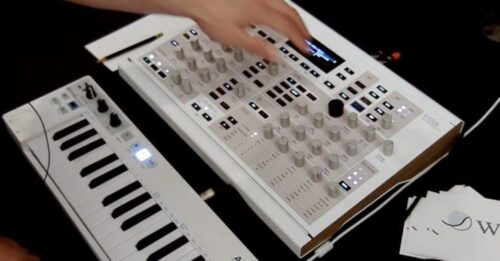Waldorf announces Kyra Discontinued and Remaining Stock Discounted
Goodbye, Kyra!
Waldorf has announced that the company is discontinuing the Kyra, a powerful, hardware virtual analog synthesizer based on an FPGA (Field Programmable Gate Array) technology.
When it was introduced, Waldorf said that using FPGA technology allowed them to create a synth with high end specs – including 128 voice polyphony, up to 1,280 oscillators, four stereo outputs and per part effects – while also being low power and fan-free.
Key Features:
- 8 multi-timbral parts – it features eight independent ‘parts’ with up to 32 notes per PART, each effectively being a complete synthesizer with sound sources (OSC GROUP 1, OSC GROUP 2, SUB 1, and SUB 2); FILTERS; modulators (EGs, LFOs, and MOD MATRIX); multi-effects unit (EFFECTS); and a USB 2.0 connection — can exchange MIDI (Musical Instrument Digital Interface) information, as well as send the audio from each stereo PART to a computer as eight stereo 24-bit streams at 96kHz (with 48kHz downsample mode available) and one stereo audio return from the computer supporting a single 24-bit stereo audio stream from the host DAW (Digital Audio Workstation). With that being said, the only other resource they share are the four balanced, stereo output pairs — OUT A (Right and Left), OUT B (Right and Left), OUT C (Right and Left), and OUT B (Right and Left) — using 32-bit DAC (Digital-to-Analogue Conversion) running at 96kHz sampling rate connected to four internal stereo busses and that powerful pool of 128 hardware voices. Versatility further abounds as each PART has a dedicated multi-effects unit comprising nine stereo effects modules — namely, three-band EQ, Formant filter, input Limiter, Distortion module, Delay module, six-state Phaser, Chorus flanger, Stereo reverb, and output Limiter — with dedicated audio stream via USB (Universal Serial Bus).
- Patches – each PART hosts a Patch from the pool available to the system. Speaking of which, Kyra has a generous Patch storage capacity of 26 banks — A through to Z, each containing 128 patches. The first seven banks are ‘user’ patches stored in RAM (Random Access Memory), meaning users can change them quickly and individually using the Store sequence. The remaining 19 banks are ROM (Read-Only Memory) patches that users can recall and use just like RAM patches but cannot be replaced using the Store sequence. It is, however, perfectly possible to freely copy whole banks between RAM and ROM, so all are user- programmable. And any Patch can be recalled via MIDI program changes and Bank select commands.
- Oscillators – Kyra has two primary virtual alias-free oscillator groups (OSC GROUP 1 and OSC GROUP 2) per voice, each with Saw (sawtooth); Wave (waveform) — with no fewer than 4,096 18-bit linear PCM (Pulse Code Modulation) single-cycle 32x oversampled wavetables covering a huge range of synthetic and emulated sound sources with two wavetable sources per voice; Pulse; and noise simultaneously available. Also, OSC GROUP 1 and OSC GROUP 2 each has an independent detune-able oscillator — SUB 1 and SUB 2 — with four selectable shapes and two selectable (Octave) pitches. Real Hard Sync, ring modulation, and FM (Frequency Modulation) are available between those oscillator groups. Switching from Wave mode — meaning Kyra adopts a virtual analogue synthesis model which has the advantage that it is easy to construct sounds using intuitive subtractive synthesis — to Hypersaw mode configures the voice to use a special algorithm comprising six real oscillators to quickly create lush-sounding soundscapes. Digging deeper, Hypersaw mode replaces Wave mode’s two oscillator groups with a single source whose tonal content is constructed with just two adjustable controls — Hypersaw Intensity and Hypersaw Spread (geometric detuning). Built entirely out of multiple, harmonically-rich sawtooth waves or ‘partials’ each adjusted to that special algorithm, the Hypersaw provides characteristic soundscapes ideal for a wide range of uses — from high-impact lead sounds through to lush, animated pads. Placed in Dual Mode, the Hypersaw has 12 real oscillator sources with an additional adjustable stereo spread.
- Filter – Kyra offers emulations of classic analogue ladder filters with 2-pole (12dB/octave) low pass (12dB LP), band pass (12dB BP), and high pass (12dB HP), plus 4-pole (24dB/octave) low pass (24dB LP), band pass (24dB BP), and high pass (24dB HP) configurations. Creatively, 128 filters are configurable for single or dual parallel (Dual Filter) true stereo operation.\
- Envelope and LFOs – three ADSR (Attack, Decay, Sustain, Release) envelope generators with EG Slope setting are also at hand. One is assigned to the VCA (Voltage Controlled Amplifier), another to the filter, while the third can be freely assigned. All are available in the MOD MATRIX (modulation matrix), itself being a six-channel affair with up to three destinations per channel giving a maximum of 18 routings. The three LFOs (Low Frequency Oscillators) — with 128 waveforms, monophonic, polyphonic, random, anti-phase, and quadrature stereo phase settings — are also available in the MOD MATRIX and additionally as a MIDI clock sync source.
- Arpeggiator – available on each PART, with 128 preset patterns; Up, Down, Random, and Chords modes; and an ability to synchronize to MIDI clock. Kyra’s ARP is an integral part of a Patch, so settings are always stored.
- Display and Connections – 256×64 pixel graphic OLED (Organic Light-Emitting Diode) display alongside the traditional array of MIDI In, Out, and Thru connections — complimenting USB 2.0 — on five-pin DIN, as well as full key microtuning capability with MIDI Tuning Standard (MTS support).
The remaining Kyra synths are now priced at 1.774,80€ instead of 1.972€. All orders now will also include a Waldorf Travelbag. Find out details on the Waldorf website.


























